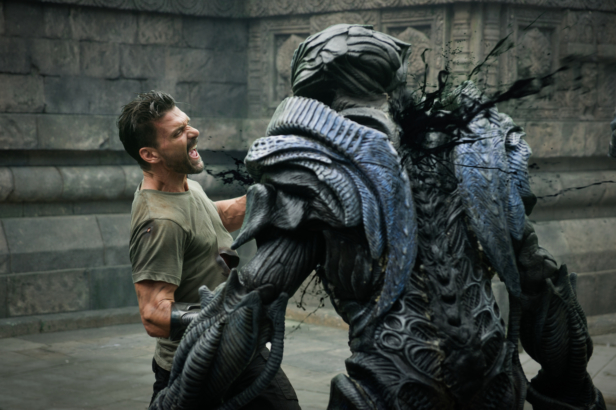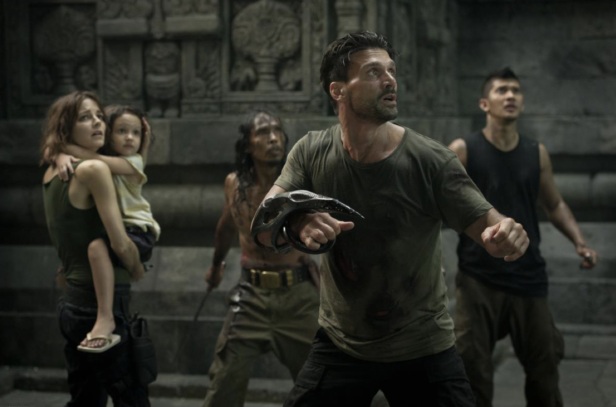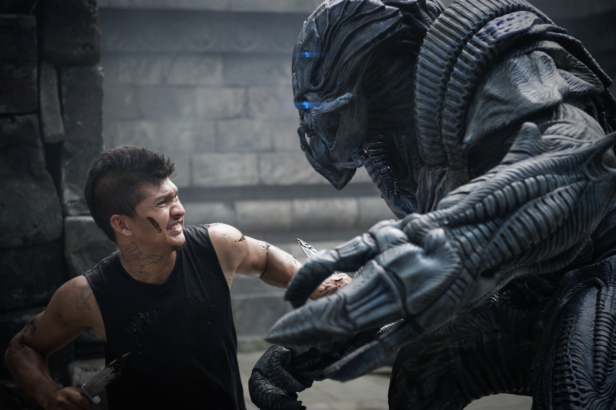In 2010, a low-budget alien invasion movie called Skyline hit cinemas and became a smash hit, but it’s fair to say that audiences were left wanting more and it’s also fair to say that the critical reception was not kind. So, when a sequel was confirmed, we were cautious to say the least. Then Beyond Skyline cast the dependably excellent Frank Grillo and The Raid‘s awesome star Iko Uwais, and it was revealed that we’d be taken on board the alien ship…and we started paying attention.
The result is a crowd-pleasing sci-fi action film that is hugely entertaining, enormously ambitious and gleefully weird as Grillo’s LA cop, his son and a group of survivors have to fight their way out of a spacecraft and find a way to turn the tide against the invaders, and writer-director Liam O’Donnell tells us that he was always going for bigger and better.
You described the first Skyline as Paranormal Activity meets Cloverfield. What would your pitch be for Beyond Skyline?
I looked at it as sort of a Die Hard, it’s definitely got War of the Worlds, and then Predator/Apocalypse Now. I love the first act of Die Hard, how you progressively get there with the characters and set everything up. There’re a couple of shots in Iko’s fight versus the pilot in the bunker that are straight homages to Arnold versus the Predator. Those were the sort of references that we were going for. It’s definitely a movie that is drunk, maybe high, on other movies!
How beholden were you to the original when you were making this film? Did you want it to stand on its own?
It’s a weird balance because I did want it to fit together, and I think originally it was much closer in how you could almost inter-edit the movies. We obviously did some recasting on our flashbacks because we were over in Indonesia and it was just a one-day shoot – scheduling worked out that way. But yeah, in my head when I was doing the treatment and script it was very much like ‘okay, how would this fit together?’. You have to honour the movie that you’re making and not the one behind it, but I think, if you use your imagination, they still kind of line up.
The first film is very much aliens in the urban environment, very immediate and close. This one’s massive, with huge scope. Did that just sort of happen organically as you were scripting this one?
There’s definitely a reaction from the first one, and a certain level of frustration because that movie was so low budget. We only had one location. Some of that was pretty cool because we knew the building really well, I’d rented there for a few years, and we were able to write it very quickly, but at the same time you don’t get to really sit down and imagine just the best possible thing. That’s why the ending got so weird and so crazy, I think, because we had all this pent up creative energy!
On this one I wanted to always be moving forward. One of the most frustrating parts of the first movie was that we had to go back up into the penthouse. I always felt that was something we should have done differently. So that was like a mantra, an overarching ‘dogma’ if you will, for what I wanted the movie to be. Propulsive, moving everything forward.
There was the earlier version of the treatment where they crashed into another city. I think once I started thinking about it as a director and not a writer, and thinking ‘how is New York or Shanghai going to look any different than LA?’ – yeah, slightly different skylines but it’s still just aliens in an urban environment – it became ‘okay, let’s think of a location that’s remote’ because we need a little time away from the aliens. If it’s over in Asia you have jungles, I love jungles, I love Apocalypse Now, and temples…the reason it became Laos is, one my wife was born there, so it is something that is obviously in my life every day, but I wanted it to be a country that had a history of conflict with the American characters, so that there was a little bit of a commentary on the way things have gone.
How was it stepping up to direct this time?
It’s the best job in the world but it was a ton of work! This whole movie was about perseverance for me. I went through a lot of different collaborators that all helped it happen, but it was definitely this crazy passion project. The great reward of the response so far is that, whether people like it or not, they seem to understand that there is a crazy amount of love that has been put into the movie.
Do you feel there’s scope for more films in the Skyline universe?
Yeah, I mean it’s so malleable! Now that we’ve done two that are just completely different. Without giving anything away, there’s a set-up at the end for something completely different, and we’ve been talking about that version, and there’s interest in it. Again, with the aliens, we see a lot more of them, we learn a lot more about them, but there’s still plenty of mysteries to uncover and new places to go. One of the great things about the ending of the first movie, and where we get to at the end here, is that it’s not a reset movie. It was never a reset movie. The world is never just going to be the same again. I just love filming like that.
Beyond Skyline is available now on Blu-ray, DVD and digital download.


